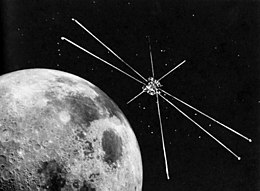Explorer 49

Artist's impression of Explorer 49 in orbit around the Moon
|
|
| Mission type | Radio astronomy |
|---|---|
| Operator | NASA |
| COSPAR ID | 1973-039A |
| SATCAT no. | 6686 |
| Mission duration | 2 years |
| Spacecraft properties | |
| Launch mass | 328 kilograms (723 lb) |
| Start of mission | |
| Launch date | 10 June 1973, 14:13:00 UTC |
| Rocket | Delta 1913 |
| Launch site | Cape Canaveral LC-17B |
| End of mission | |
| Last contact | August 1977 |
| Orbital parameters | |
| Reference system | Selenocentric |
| Periselene | 1,123 kilometers (698 mi) |
| Aposelene | 1,334 kilometers (829 mi) |
| Inclination | 61.3 degrees |
| Epoch | 15 June 1973 |
| Lunar orbiter | |
| Orbital insertion | 15 June 1973, 07:21 UTC |
Explorer 49 (also called Radio Astronomy Explorer-B(RAE-B)) was a 328 kilogram satellite launched on June 10, 1973 for long wave radio astronomy research. It had four 230-meter long X-shaped antenna elements, which made it one of the largest spacecraft ever built.
Explorer 49 was launched after the termination of the Apollo program, and although it did not examine the Moon directly, it became the last American lunar mission until the launch of Clementine spacecraft in 1994.
This mission was the second of a pair of Radio Astronomy Explorer (RAE) satellites, Explorer 38 or RAE-A being the first. Explorer 49 was placed into lunar orbit to provide radio astronomical measurements of the planets, the Sun, and the galaxy over the frequency range of 25 kHz to 13.1 MHz. Since the spacecraft's design used gravity gradient booms, the lumpy lunar gravity field was a problem for the mission scientists.
Explorer 49 was placed in lunar orbit to record radio measurements from 25 kHz to 13.1 MHz of the Milky Way galaxy. Explorer 49 was placed in to lunar orbit so that radio waves from earth would not be as big of an interference as Explorer 38 had discovered.[1]
The principal investigator for all the experiments was Dr. Robert G. Stone.
1.Step Frequency Radiometers- Explorer 49 was equipped with two Ryle-Vonberg (RV) receivers one on the upper V-antenna and the other on the lower V-antenna.The radiometers were designed to measure at nine frequencies from .45- 9.18 MHz.[2]
2.Rapid-Burst Receivers- Explorer 49 had three rapid burst receivers, one on the upper V-antenna one the lower V-antenna and the third on the middle dipole antenna. The Burst Receivers were composed of a pair of IF Amplifiers and detectors one of the pair was used for back up. They detected on 32-channel's between 25 kHz to 13.1 MHz.[3]
...
Wikipedia
